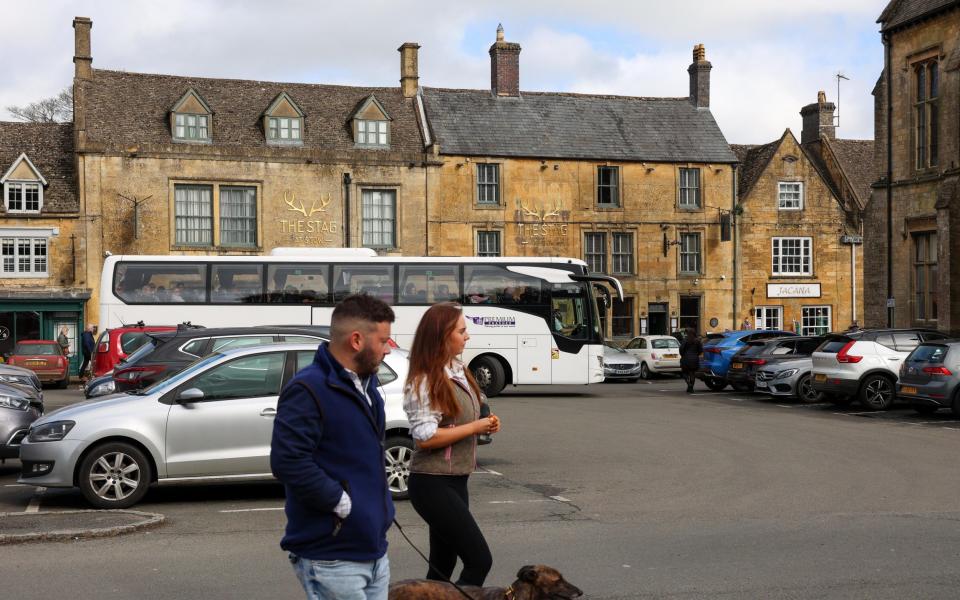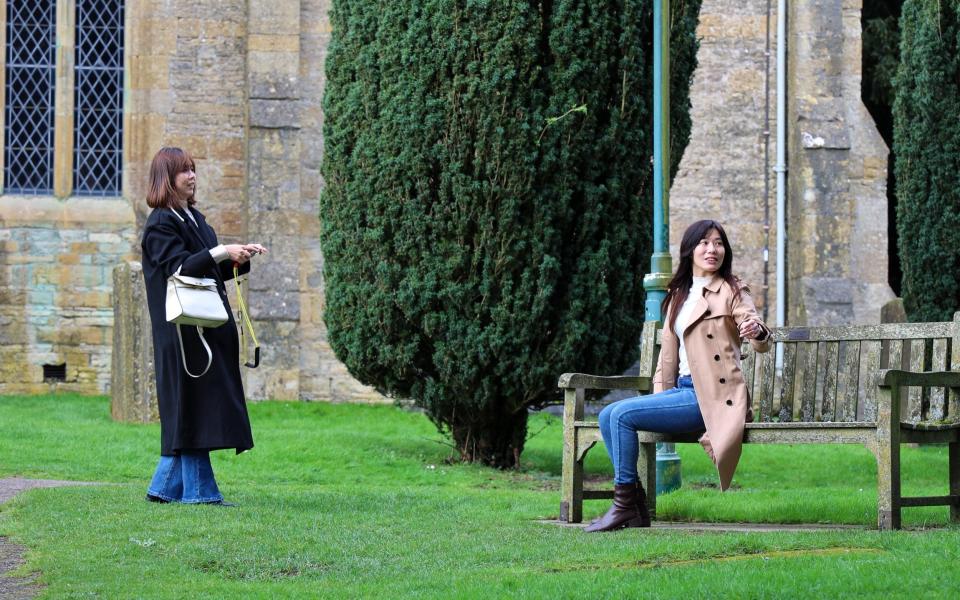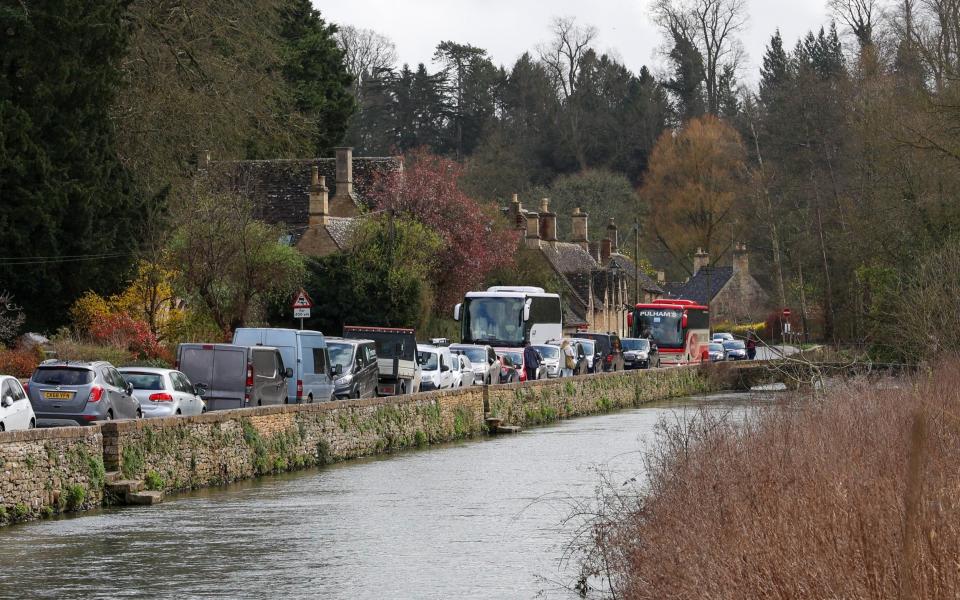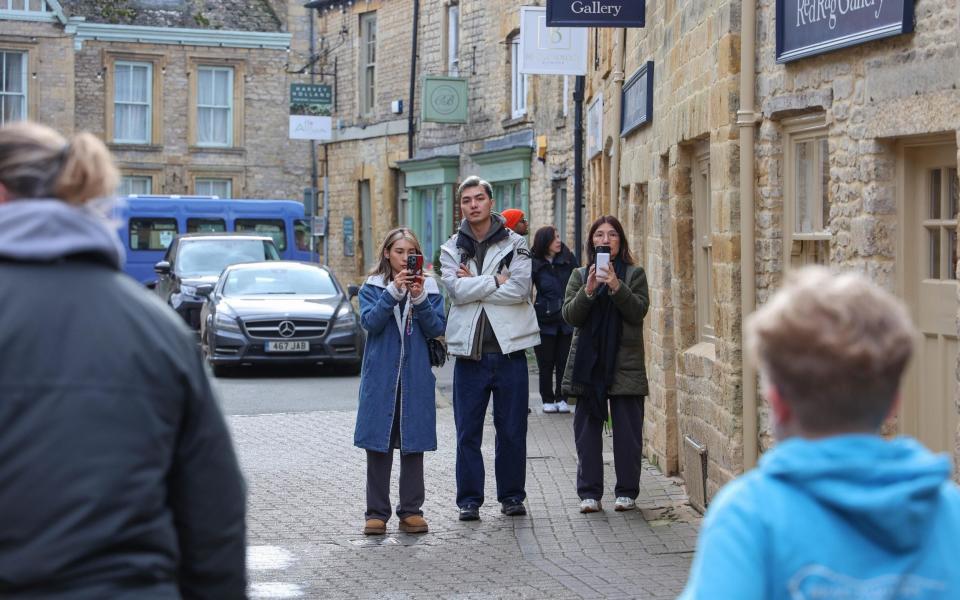“All aboard for lunch in the Cotswolds,” says Derek Lavery, beaming as he checks off the names on his clipboard.
It’s 8am at Victoria Coach Station and I’m boarding the Premium Tours ‘Lunch in Britain’s Most Beautiful Village’ bus to meet the people who are persona non grata in at least one Cotswolds honeypot.
Perhaps predictably, I’m the only Brit in a group of 48, surrounded by a bunch of American, Australian, Chinese and Japanese tourists. Eighteen Americans have arrived together and are chatting in the back rows.
“This is one of the best tours of the British countryside you can take. We will see some of the most beautiful views in the country and enjoy a delicious pub lunch,” Lavery continues. And with that we left.


Buses like these risk a ban from Bourton-on-the-Water, a village of just over 3,000 residents that attracts huge numbers of tourists. Around 238,000 visitors come to Bourton every year and enjoy the sights and sounds of the medieval village with its picturesque Cotswolds limestone houses, the shallow River Windrush – perfect for paddling – and old-fashioned British pub food.
The proposed ban would prevent access for coaches but has not yet been officially signed off by Gloucestershire County Council’s highways authority. Nevertheless, a de facto ban has already been introduced.
A former car park near the city center was closed in December and the replacement car park, which opened in February, no longer has spaces for coaches. They either have to use unofficial drop-off points that are difficult to turn into, or – as we do – skip Bourton altogether.
‘Only they will lose’
“It’s a shame,” said Sue, who traveled from South Australia with her 11-year-old grandson. “I’ve been there once, probably about thirty years ago, and it’s a very beautiful city. But they are all very beautiful. If they don’t want tourists there, there are plenty of other places to visit. I’m not that disappointed.”
“I think it’s ridiculous,” says Lavery when I ask him about the plans. ‘Only they will lose. Bourton-on-the-Water is beautiful and very picturesque, but there is nothing there. If they keep tourists out, the entire village will collapse. All the pubs, cafes, restaurants and shops are gone.”
Instead we spend more time in the surrounding villages: Burford, Stow-on-the-Wold and Bibury, our ‘most beautiful village in Britain’ for lunch.
The two-hour journey from London to the Cotswolds is fairly unremarkable, yet Lavery keeps us entertained with a stream of facts and anecdotes, covering everything from the famous residents of the Cotswolds to the sheep farming scene.
“I love it, it’s so cute!” exclaims Jessica, a fiftysomething Californian. Although she has visited Britain once before, this is her first time away from London and she “can’t get over how beautiful it is”.


Bourton-on-the-Water’s avoidance of coaches did not receive unanimous support from locals. Pub landlords, cafe operators and gift shop traders have already expressed their disappointment – and neighboring villages are seeing the bright side.
“Bourton’s loss is our gain,” shrugs the lady behind the tills of the sweet shop in Burford. “Tourists are not a problem here, they arrive mid-morning and then leave at 4 p.m. It’s not like we’re being swamped.”
Our tour group arrives at Burford at 10:30 am, next to the Priory, which belongs to Elizabeth Murdoch, daughter of the newspaper magnate. Lavery points out the medieval church, toilets and where you can get a local delicacy: lard cake, a sweet baked roll with currants and lots of sugar.
My fellow visitors are enchanted. A few American party members have been there before, “in 1978 – I loved it, meeting the locals – oh the stories,” enthuses Michael Baker, a retired California sheriff who leads their group. “It hasn’t changed a bit. It’s beautiful. This is what you want to see when you go out in Great Britain. I could easily live here. Easy.”
Then it goes back on the bus.


We stop for lunch at The Swan Brasserie in Bibury. It is a picturesque and chic hotel, located in the greenery next to the River Coln. Across the water I see Arlington Row, a small parade of 14th-century limestone cottages owned by the National Trust and rented to locals.
There is a group of Japanese tourists taking pictures of it. Bibury is especially popular with the Japanese because the country’s crown prince visited in 1921 during his tour of Europe. He loved Bibury so much that he spoke of it fondly when he returned to his country, making the village famous in Japan.
At lunchtime there is a palpable excitement among the other visitors at the idea of visiting a proper English ‘pub’ (never mind that it is the dining room of a country hotel). Lavery needs to explain the etiquette of ordering at the bar as there is some confusion.
We have a choice of three options: roast chicken and mashed potatoes, fish pie and ravioli, followed by sticky toffee pudding or crumble. Typically British (except the ravioli). Lunch is included in the ticket price, but a quick look at Swan’s a la carte menu suggests it would probably cost around £30 per person if we just got there. We may not contribute a fortune to the Cotswolds economy, but we spent the day visiting cafes, tearooms and gift shops. On the bus I see my fellow passengers holding everything from local sheepskins to woven baskets, sweets, books and waxed jackets. It all adds up.
It’s also worth noting that coach groups like ours provide a steady stream of guests to places like The Swan, even out of season. Premium Tours runs all year round, rain or shine. According to Lavery, the current group is slightly larger than average at 48 years old, but 25-40 is a typical size.


An old cliché in the Cotswolds, at least since coach travel began in earnest in the 1960s, is that although it is impossible to find a weekday lunch in these parts, tourists don’t worry about it when booking an evening dinner. By then I’ll be back on the bus. Not the worst trade-off in the world, you might say.
The lunch was well received, despite the slightly late service. “This whole thing works with mechanical precision,” Lavery tells me. “If a bus tour is ten minutes late, that slows down the service and that pushes everyone back.” Yet Americans rave about how British it all is.
From there we would normally go to Bourton-on-the-Water, but instead we go straight to Stow-on-the-Wold. The Normandy market town is the epitome of chocolate boxes. At its core, it almost seems as if it emerged from foreigners’ wildest imaginations as an example of what Britain stands for.


Stow-on-the-Wold is received with as much joy as Burford and Bibury. The group dutifully queues for selfies outside the church, where two yew trees grow on either side of the door (supposedly the inspiration for the Gates Of Moria from Tolkien’s Lord Of The Rings) and I hear shouts of delight from gift shops. and antique shops as we wandered around for an hour.
The local response to tourists in Stow is not exactly enthusiastic, but rather grudgingly accepted. “It can be tricky in traffic and it’s a bit of a pain to be left behind taking selfies when I go somewhere, but at the end of the day they pay the bills,” says Paul Worthy, as he drops off some hand-me-downs at the charity shop.
Having grown up in a tourist hotspot, I appreciate the concerns of parishioners in Bourton-on-the-Water. At best, overtourism is a terrible nuisance, preventing locals from enjoying the homes and amenities. At worst, it drives up prices, erodes communities and pits people against each other.


But after experiencing an utterly delightful bus journey, I can’t help but feel that Bourton has chosen the wrong face of tourism to ignore. My compatriots on the tour were interested, engaged, respectful and – because they were willing to pay £121 for a day out – wealthy enough to indulge in local shops and restaurants. We overstayed our welcome in any particular place and stayed in each village just long enough without running under anyone’s feet.
Okay, so a big coach turning around can hold up traffic for a few minutes, but what’s worse: one coach or 24 cars clogging the roads? Best of all, we left at four o’clock so the locals could enjoy their area in peace.
Jack traveled on Premium Tours’ ‘Lunch in Britain’s Most Beautiful Village’ coach tour, starting at London Victoria Coach Station and visiting Burford, Bibury and Stow-on-the-Wold.